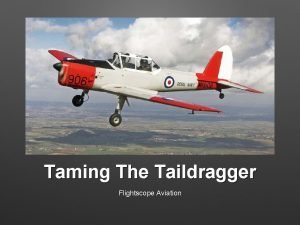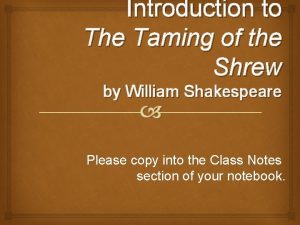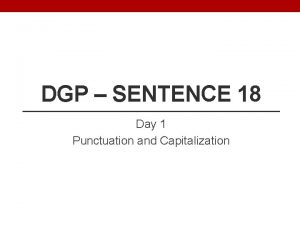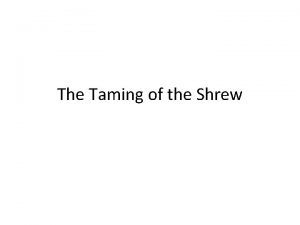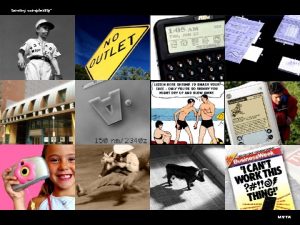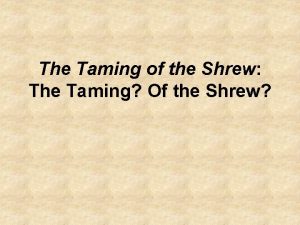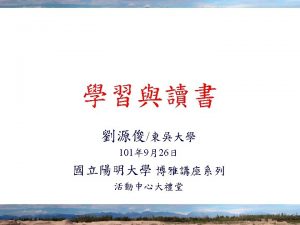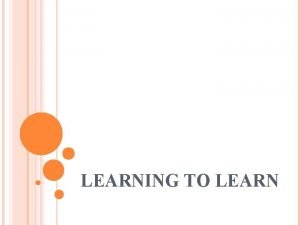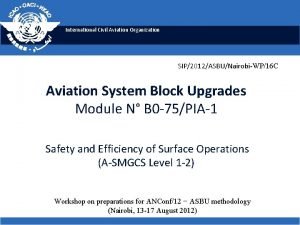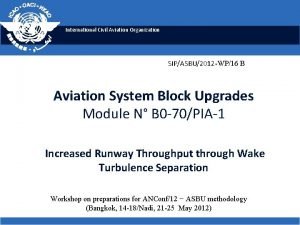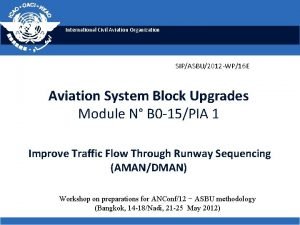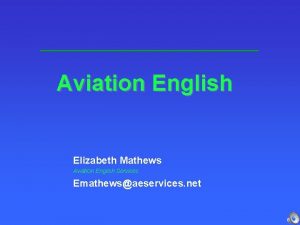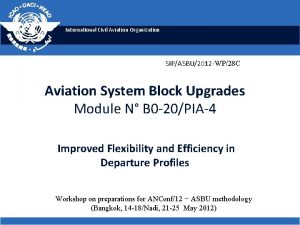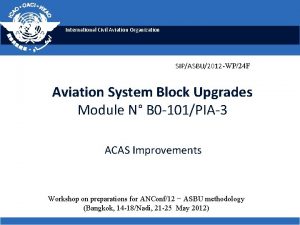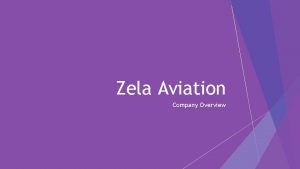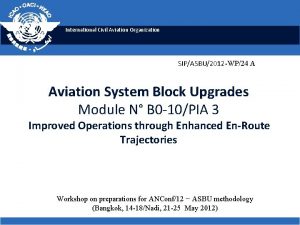Taming The Taildragger Flightscope Aviation Aims To learn

























- Slides: 25

Taming The Taildragger Flightscope Aviation

Aims • To learn theory behind the ancient art of flying a taildragger (or tailwheel) airplane.

Objectives • At the end of this lesson, the student will be able to: • State the reason why taildraggers are inherently unstable; • Explain what a ground loop is; • Differentiate between a wheeled landing and a three pointer; • Adequately explain the differences in operations as opposed to a nose wheel airplane.

Some History • Until the mid-1950 s, all students from ab initio trained on tailwheel airplanes. • With the introduction of the Cessna 172 in late 1955 and the “Land-O-Matic” gear, as it was marketed, the nosewheel airplane overtook the taildragger. • Taildraggers are less forgiving than a nose wheel airplane and require a heightened sense of control, from chock to chock.

General Handling

Landing Gear • Two main gear and one aft tailwheel (hence the name). • Main gears are ahead of the airplane’s Centre of Gravity. • Tailwheel also supports weight but main functions are directional control and steering. • Can be lockable and/or free castoring or steerable with the rudder pedals.

Stability • Tailwheel airplanes are unstable on the ground because the Centre of Gravity is behind the main wheels - unlike a nose wheel airplane where the CG is in front of the main wheels. • When turning, the aircraft pivots about one of the main wheels. • From that point, with the CG aft of the pivot point, the forward momentum of the plane acts to continue and even tighten the turn without further steering inputs. • It is vital that one apply opposite rudder input to stop a turn during taxi, not just neutralise it.

Angle of Attack - Ao. A • Due to the low tail (and hence a high Ao. A), a taildragger makes lift at any time it is in motion, be it one knot or 65 knots. • As long as there is a relative headwind, the wings of a taildragger will be making lift. • The amount of lift evidently depends on airspeed but even during a slow taxi, the wings and ailerons are aiding in takeoff.

Weathervaning • Tailwheel airplanes have an exaggerated tendency to weathervane when operated in crosswinds. • This tendency is greatest when taxiing in a direct crosswind. • As usual, keep the ailerons into the wind. • If need be, use the brakes to counteract any weathervaning action but do not ride the brakes.

P Factor • P-factor is caused by unequal thrust generated by the different propeller blades. • Enhanced in a taildragger (as opposed to a nosewheel airplane) at takeoff due to the inherent higher Ao. A. • As power is increased, the airplane has a tendency to yaw to the left due to the difference in Ao. A between the upgoing and downgoing propeller blades.

Gyroscopic Rigidity • As the tail comes up on takeoff, a force is applied to the top of the propeller. • Since the propeller is spinning clockwise, that force is felt 90 degrees to the right. • That forward-moving force, on the right side of the propeller, creates a yawing motion to the left.

Propeller Torque • Torque effect is the influence of engine torque on aircraft movement and control. • Generally exhibited as a left turning tendency in piston single engine aircraft. • According to Newton's law, "for every action there is an equal and opposite reaction, " - if the prop is turning clockwise, there is a tendency for the aircraft to rotate counterclockwise. • This pushes the left wing down.

Propeller Slipstream • The high-speed rotation of an aircraft propeller gives a corkscrew or spiraling rotation to the slipstream. • At low forward speed but high RPM, this force is at its peak, hitting the tail and creating left yaw. • Most aircraft are fitted with clockwise turning props, meaning that the slipstream will create left yaw, necessitating right rudder.

Ground Looping • A ground loop occurs when the airplane loses directional stability and rotates about the horizontal axis of the aircraft. • The tail will want to spin around the nose of the aircraft as it is disturbed from a straight line. • Forward momentum will carry the airplane around until the tail of the aircraft is headed in the direction that the aircraft nose was originally aimed if no correction is made. • To avoid a ground loop, maintain a straight track over the ground during the rollout after touchdown.

Ground Looping

Taxiing

Taxiing • Test the brakes immediately after starting to move. • Keep the stick back and ailerons into wind. • • Keeping the stick full aft maximizes the weight and controllability of the tailwheel. • If there is a strong tailwind, keep the stick neutral. Because visibility is reduced over the cowling, it is best to perform small “S” turns down the taxiway to increase forward visibility.

Taxiing • Taxi slower than you would in a nosewheel airplane. • Stamping on the brakes to stop in an emergency could cause the airplane to nose over - thus, it is very important to be conscious of your speed and surroundings when taxiing. • More rudder movement is needed to start and stop a turn at slower speeds. • Remember to apply opposite rudder to stop a turn. DO NOT just neutralise the rudder.

Takeoffs

Takeoffs • Keep stick full aft until you are sure you will raise the tail. • Apply full power slowly. • Be ready to keep it straight down the runway with right rudder. (Due to Torque and P Factors. ) • As the airplane accelerates, smaller inputs will be needed as airspeed and rudder effectiveness increase. • The airplane should be allowed to accelerate with the tailwheel firmly down until the rudder becomes effective. • When the tail is raised, the airplane will fly itself off the runway. Don’t spend the whole takeoff roll looking at the ASI; your priority is to keep the airplane straight.

Landings

Types of Landings • “Wheeler” landing. • • “Three Pointer” landing. • • Main gear contacts the runway; tailwheel still in the air upon touchdown. All three wheels contact the runway at the same time. Remember, the best landings start from the approach. If the approach is unstable, go around and try again. NEVER think you have to “save” a landing.

Three Pointer Landing • Attitude same as taxi attitude! • Stick fully aft and keep it there! • Be ready to dance on the rudder pedals - keep it straight or you risk ground looping.

Three Pointer Landing

Wheeler Landing • Arguably more difficult than a three pointer. • Touchdown attitude is very nearly level, or at least tail low (but not so low that it becomes a three pointer).
 Weathervaning tendency is greatest when taxiing
Weathervaning tendency is greatest when taxiing Kinesthetic learning
Kinesthetic learning Is 10 things i hate about you based on taming of the shrew
Is 10 things i hate about you based on taming of the shrew Characters in taming of the shrew
Characters in taming of the shrew Taming of the shrew disguises
Taming of the shrew disguises Motherless
Motherless Notice neptune though taming a seahorse meaning
Notice neptune though taming a seahorse meaning The taming of the shrew
The taming of the shrew The taming of the shrew setting
The taming of the shrew setting After we read the play the taming of the shrew
After we read the play the taming of the shrew Taming the tiger within
Taming the tiger within Metaphor in taming of the shrew
Metaphor in taming of the shrew Allusions in speak
Allusions in speak Chúa sống lại
Chúa sống lại Khi nào hổ con có thể sống độc lập
Khi nào hổ con có thể sống độc lập đại từ thay thế
đại từ thay thế Vẽ hình chiếu vuông góc của vật thể sau
Vẽ hình chiếu vuông góc của vật thể sau Công thức tính thế năng
Công thức tính thế năng Tỉ lệ cơ thể trẻ em
Tỉ lệ cơ thể trẻ em Thế nào là mạng điện lắp đặt kiểu nổi
Thế nào là mạng điện lắp đặt kiểu nổi Các loại đột biến cấu trúc nhiễm sắc thể
Các loại đột biến cấu trúc nhiễm sắc thể Lời thề hippocrates
Lời thề hippocrates Vẽ hình chiếu đứng bằng cạnh của vật thể
Vẽ hình chiếu đứng bằng cạnh của vật thể Quá trình desamine hóa có thể tạo ra
Quá trình desamine hóa có thể tạo ra Phản ứng thế ankan
Phản ứng thế ankan Môn thể thao bắt đầu bằng chữ đua
Môn thể thao bắt đầu bằng chữ đua
